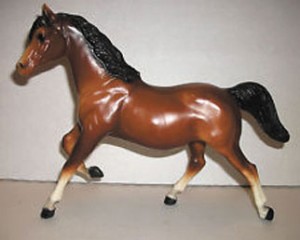Sometimes in life things don’t go according to plan, but with the passage of time, we realize they turned our even better. Such was the case for the Breyer Molding Company of Chicago. In 1950 they were contracted to make a mold of a horse with a western saddle to be used to decorate a mantel clock. The clock sold very poorly and the clock company went out of business. However, Breyer maintained the copyrights for the mold and so started their long history as the manufacturer of toy horses. Today, over 60 years later, the fine quality and realistic appearance of Breyer horses have made them one of the most collectible model horses in the world.
Throughout the 1950s and 60s the majority of animals produced by Breyer Molding were the creation of their lead designer Chris Hess. Early 50s cellulose acetate issues were mostly dogs and horses. In the 1960s cats, wildlife and farm animals, including a number of breeds of cattle, were added. Each of these early animals was cast in a two-piece mold and then assembled, sanded, polished and airbrushed by hand. The meticulous attention to detail resulted in animals that were almost life-like.
While there were strict standards set by Breyer to assure consistency, variations sometimes occurred. One common example is the Proud Arabian Stallion (PAS model) which, in it’s intended form, has a dappled gray coat with a gray mane, hooves and tail. There are however a number of that were shipped from the factory in all black. A PAS in black is a rare find and worth several times the value of the gray model.
Through the years a number of the molds have been used with different accents and color combination. One of the more popular models, the Family Arabian Stallion (FAS), first issued in 1956, has been issued with Appaloosa blankets, various socks and blazes and Native American painted decoration. Many of their horses are also available in either matte or glossy finish. You will also find some Breyer horses that were produced in unrealistic colors. These special issues are referred to as “decorator models.” Three of the more common are the filigree horses painted with blue and gold splotches, a translucent form made to look like blown-glass and a recently released two-tone metallic model. Decorator horses are most commonly released in limited edition which adds to their value.
There are six basic scales for Breyer horse models: Traditional 1:9 scale, which is 8 inches high and 11 inches long; Classic, Ponies and Pony Gals 1:12 scale, which will be 7 inches high and 5 inches long; Paddock Pal 1:24 scale, measuring 6 inches high and 4 inches long; Little Bits measuring from 4 to 4 1/2 inches tall; Stable Mates 1:32 scale: and Mini Whinnies 1:64 scale.
Finding Breyer horses has not always been easy. In the early part of the 1980s Kaybee, the long time distributor for Breyer, dropped the once popular animals due to lack of interest. They would remain unavailable in retail stores for over a decade before being picked up by Toys R Us.
After the introduction of the Internet, and the subsequent phenomena of eBay, Breyer was as easy to purchase as turning on a computer. However, the glory days of online selling were short lived as misinformation, unrealistic pricing and misrepresentation drove down values.
In 1992 the first computer designed Breyer horse,”Mesteno the Messenger,” designed by sculptor Rowland Chesney, appeared. While these horses are still considered of high quality, they are of little interest to serious collectors who watch for horses manufactured before 1988. Until next time………Linda
Linda Kennett is a professional liquidation consultant specializing in down sizing for seniors and the liquidation of estates and may be reached at lkennett@indy.rr.com or 317-258-7835



